Small businesses are often described as the ‘backbone of the US economy’, major sources of local employment, and vital parts of local communities. Yet the US small business economy faces many challenges that can mean the difference between staying open and folding.
Small to medium business (SMB) owners are constantly navigating a dynamic landscape. And, in challenging economic periods, every decision counts—especially when it comes to marketing. It might seem tempting to scale back on budgets and channel spend, particularly in areas that can often be misunderstood, like SEO and local SEO. However, focusing on organic search and local visibility is crucial, and we believe even more so in a downturn.
So, why do only 35% of SMBs have a Google Business Profile, and just 40% have a dedicated website?
This research aims to highlight key areas of marketing where owners are struggling, and provide clear recommendations to help you recognize opportunities for smarter, long-term marketing strategies.
Methodology
We conducted a survey with a panel of small to medium business owners and managers in the US, to measure:
- Feelings towards the current US economy and current business health
- How key business functions are managed within SMBs
- Platforms used for online marketing
- Perceived impact of marketing channels
A total of 778 SMB owners or managers completed the survey.
Throughout this report, we’ll combine the findings of our primary research with secondary data to provide an honest picture of the small to medium business landscape in 2025.
1. Economic impact on small businesses
Despite our findings showing that challenges are affecting cash flow and profitability, the majority of SMBs remain optimistic towards the US economy and their own business health for the 12 months ahead.
“Uncertainty is pulling business owners out of a growth mindset and into stability mode.”
– Amy Friedrich, President (Benefits and Protection), Principal® (source: Financial Well-Being Index)
Business optimism vs. economic reality
Alongside new business tariffs increasing the cost of goods for many and consumer confidence shrinking in June 2025, Gross Domestic Product (GDP) has seen a contraction of 0.5%. This marks the first GDP decline since 2022.
Using data from the MetLife and U.S. Chamber of Commerce Small Business Index (SBI) and Principal®’s Financial Well-Being Index℠ (FWBI), here’s a snapshot of the SMB environment currently:
- Q4 2024: SBI score was 69.1 out of a possible 100.
- Q1 2025: SBI score dropped to 62.3.
- Q2 2025: SBI score climbs to 65.2.
- ‘Wave 1’ 2025: FWBI℠ small businesses score 5.69 out of a possible 10.
The FWBI℠ small business score is lower than the ‘all business average’ of 6.02, which is the lowest score since the Index was created in 2021.
Overall, the fluctuations in these scores reflect the wavering confidence among business owners navigating the current climate.
| Significantly increased | Slightly increased | |
|---|---|---|
| Material/inventory costs | 30% | 40% |
| Labor costs | 28% | 35% |
| Premises costs (eg. rent, energy) | 26% | 40% |
| Regional or national competition | 25% | 28% |
| Local competition | 23% | 26% |
With this in mind, we asked SMBs what impact the current US climate has had on key areas of their business.
70% of business owners and managers said they’ve seen costs of materials or inventory increase as a result, and 66% have seen premises costs, such as rent, increase.
One of the most challenging decisions SMBs will be facing in the wake of rising costs is whether they should pass these increases on to their customers or try to absorb them.
Since new tariffs have been introduced, early economic evidence from the Tax Foundation has shown that it is, in fact, US businesses and consumers that are hit the hardest by cost increases, as opposed to international importers.
| Slightly decreased | Significantly decreased | |
|---|---|---|
| Cash flow | 18% | 8% |
| Consumer demand | 17% | 5% |
| Availability of labor | 16% | 5% |
| Profitability | 19% | 7% |
| Marketing and promotional budget | 13% | 4% |
While the majority of SMBs have seen increases or at least stability across cash flow, availability of labor, consumer demand, profitability, and marketing budgets, a significant proportion of businesses have been negatively impacted.
Over a quarter (26%) have seen decreases in cash flow and profitability as a result of the current US economy.
It’s understandable, then, that 17% of SMBs said they have decreased marketing and promotional budgets as a result. As discussed at the start of this report, marketing costs are often the first port of call when it comes to making cuts.
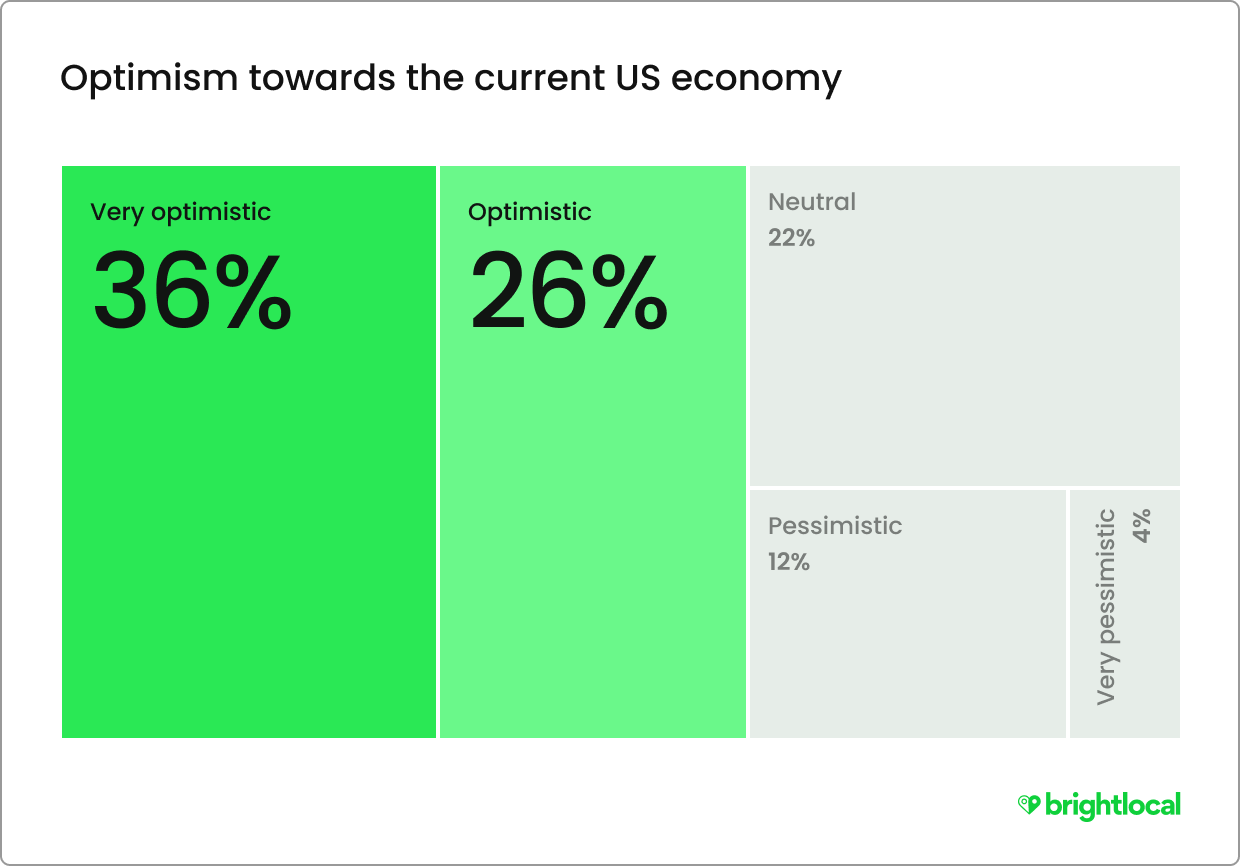
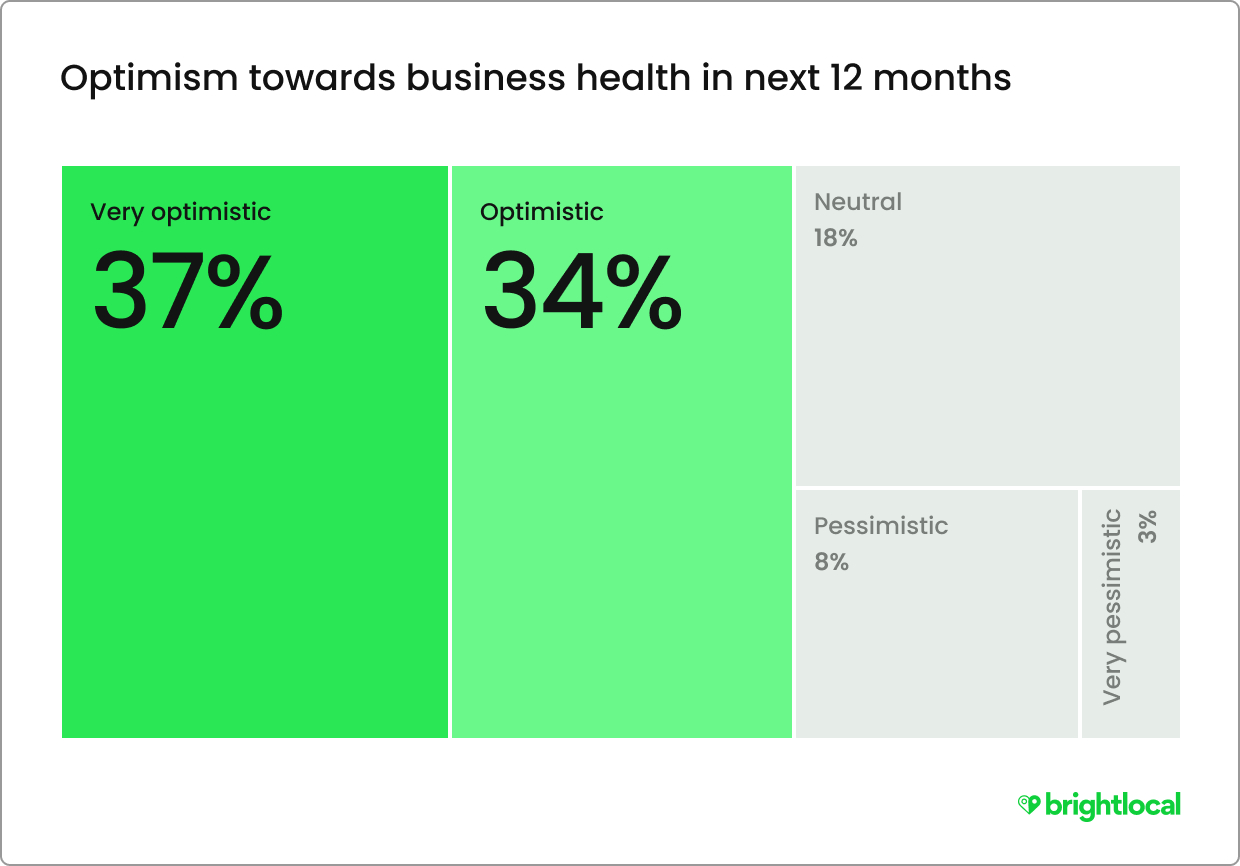
Yet, despite all of this, SMBs are feeling largely positive about the economy for the next 12 months, with only 16% of them feeling pessimistic. It suggests a sense of ‘things can only get better’ but also nods to the resilience of America’s small businesses.
Similarly, a heartening 71% of SMBs feel optimistic about their own businesses’ health for the 12 months ahead. Just 11% said they feel pessimistic about their business health.
We’ll explore some of the reasons some small to medium businesses may feel more optimistic than others in the next section of this report.
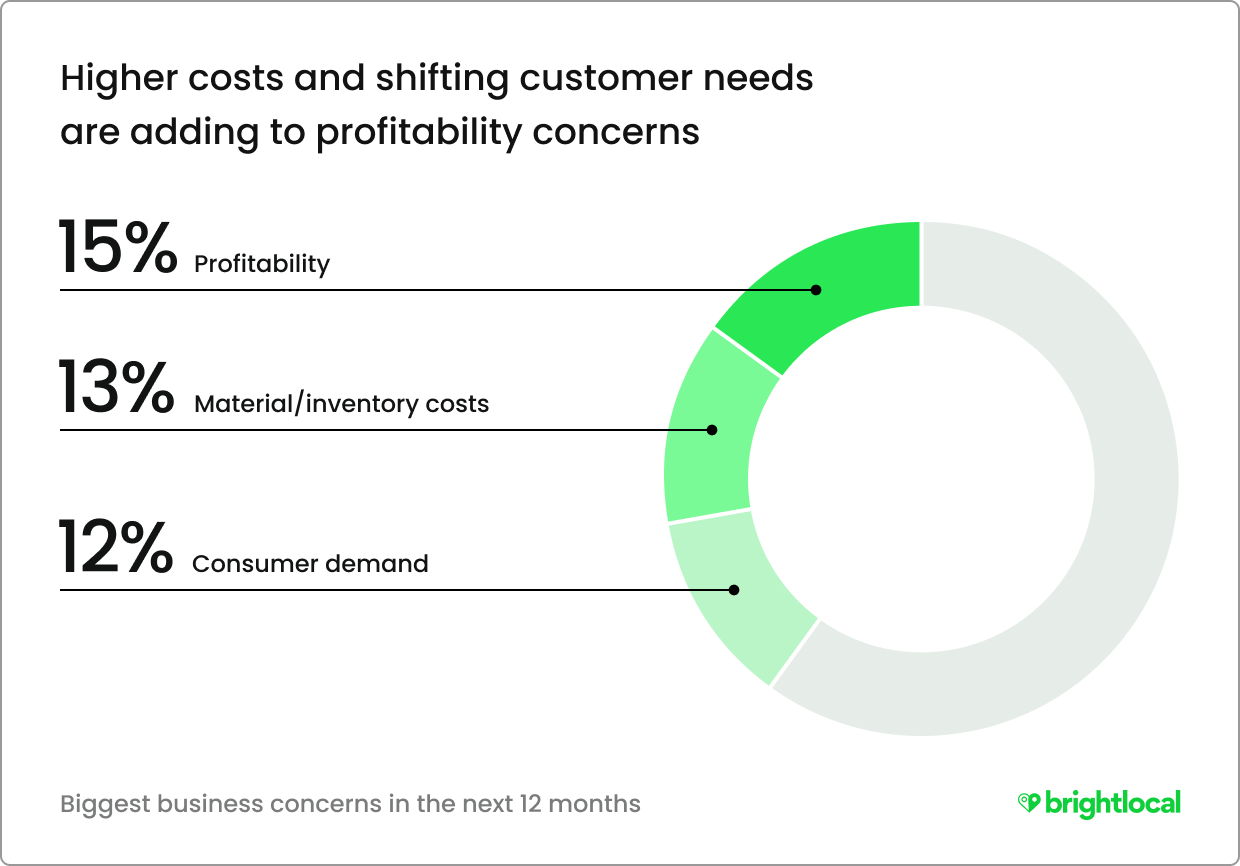
Challenges for the year ahead
When asked about the areas of business SMBs are most concerned about, the results reflect the areas that have been impacted by the current economic climate.
The top three concerns for small to medium business owners are profitability, material costs, and consumer demand.
According to the National Small Business Association (NSBA), constant changes to business tariffs are not only causing concerns around rising material costs, but creating disruption in terms of long-term supplier relationships.
Such disruption understandably makes it much more difficult for SMBs to plan ahead, forecast revenue, and assign budget for areas such as promotional activity.
2. The state of small business marketing
We uncover a gap between marketing channel investment and their perceived impact, and examine the digital platforms that SMBs are using to market themselves online.
Marketing goals and channel investment
It sounds simple, but any business’s marketing goals should involve measurable objectives that align directly with overall business goals.
And yet, so often, businesses become distracted by chasing desirable metrics without considering how it all fits into the bigger picture.
We asked SMBs about their primary marketing goals, forcing them to narrow the options down to just one choice. We’ve presented the top five marketing goals below:
- Attract new customers (20%)
- Increase sales/revenue (18%)
- Customer satisfaction (15%)
- Increase brand awareness (13%)
- Increase leads/inquiries (10%)
Notably, the top two goals of attracting new customers and increasing sales are fairly close.
| Marketing channel | Do not invest in this area |
|---|---|
| Broadcast advertising | 27% |
| Out-of-home advertising | 22% |
| Digital PR | 20% |
| Print advertising | 20% |
| Direct marketing | 18% |
| Paid social | 16% |
| Email marketing | 13% |
| Paid search | 13% |
| Local events, sponsorships, and community engagement | 12% |
| Local SEO | 11% |
| SEO | 11% |
| Organic social | 8% |
With these goals in mind, we also wanted to look at the marketing channels SMBs are investing in to see how well the two align.
Although ‘traditional’ marketing channels can be expensive to implement and difficult to measure, it’s notable that broadcast, out-of-home, print, and direct marketing are among the least invested in, particularly when we consider that the primary goal for 20% of SMBs is attracting new customers.
On the whole, though, SMBs appear to be investing strongly in their digital presence.
- Just 8% of small to medium businesses said they don’t invest in organic social media;
- While 11% are not investing in SEO or local SEO, respectively.
Marketing channels with perceived ‘high impact’
| 'Optimistic' SMBs | All SMBs | |
|---|---|---|
| SEO | 43% | 35% |
| Organic social | 32% | 28% |
| Local events, sponsorships, and community engagement | 34% | 28% |
| Paid search | 34% | 27% |
| Paid social | 33% | 27% |
| Local SEO | 32% | 25% |
| Email marketing | 31% | 25% |
We see a wider trend when comparing channel investment of those who feel optimistic and those who feel pessimistic about the year ahead.
Those businesses reporting a sense of optimism for the 12 months ahead appear to be investing more broadly in their marketing mix, whereas we can see that businesses feeling pessimistic are investing much less across the board.
There are multiple reasons for businesses choosing not to invest in certain marketing channels, from the cost of investment to a lack of internal expertise.
In fact, 36% of SMBs told us that cost is holding back from investing in marketing channels. But the differences between the two groups are telling.
While it isn’t hard evidence to say that a mix of online and offline marketing channels is the best way forward, it’s a good reminder to review your business’s marketing activity in line with its primary goals, and how that fits into the wider company goals.
Perceived impact of marketing channels
For the businesses that are investing in marketing, we asked them how impactful they perceived each channel to be for their business.
Despite 89% of SMBs saying they invest in local SEO, less than one third (29%) of this group feel it has a high impact on their business, placing it at the lower end of the channel list. Alongside this, just over a third (36%) feel that local SEO has little to no impact on their business.
These findings suggest that there is a knowledge gap for SMBs when it comes to local marketing. The high level of investment shows that they know they need it, but the varying levels of impact suggest that business owners or managers don’t know exactly what they need to be doing to get it right.
| High impact | Medium impact | Low impact | No impact | |
|---|---|---|---|---|
| SEO | 40% | 32% | 19% | 9% |
| Broadcast advertising | 33% | 33% | 23% | 12% |
| Paid social media | 32% | 35% | 20% | 13% |
| Local events, sponsorships, and community engagement | 32% | 33% | 24% | 11% |
| Digital PR | 31% | 34% | 22% | 14% |
| Paid search | 31% | 33% | 25% | 12% |
| Organic social media | 30% | 38% | 22% | 10% |
| Local SEO | 29% | 36% | 27% | 9% |
| Email marketing | 29% | 34% | 24% | 12% |
| Direct marketing | 29% | 34% | 25% | 13% |
| Out of home advertising | 29% | 32% | 25% | 13% |
| Print advertising | 27% | 33% | 26% | 13% |
Digital platforms used by SMBs
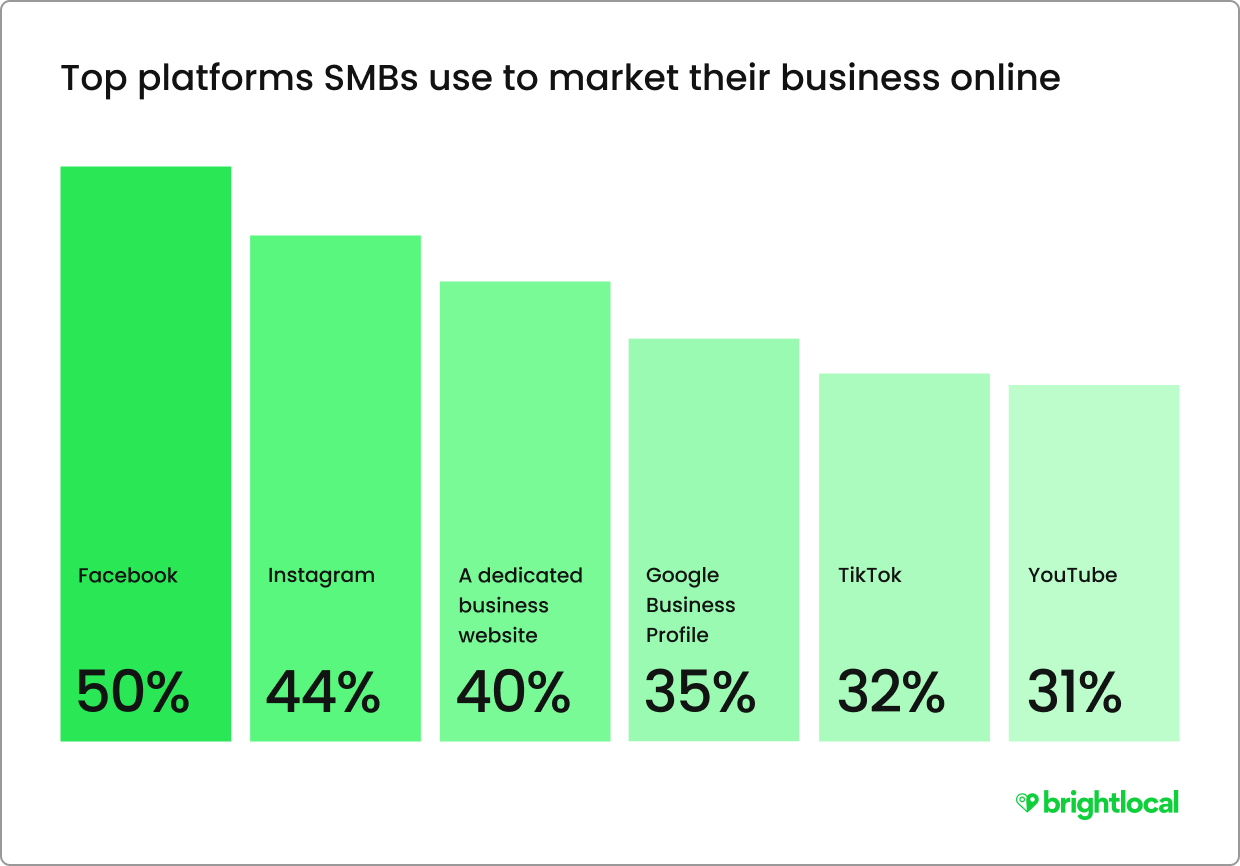
One of the most shocking findings is that, despite 89% of SMBs saying they invest in organic SEO, only 40% of them say they have a dedicated business website. This comes after Facebook (50%) and Instagram (44%). This finding alone confirms the knowledge gap theory that we’ve started to explore.
Our small-scale study into ‘near me’ optimization‘ found plenty of local businesses appearing in the local pack (or map pack) without a dedicated business website of their own. This led us to conclude that local pack rankings (i.e. local SEO) favor proximity. Organic search engine results (SERPs), however, favor on-page signals (i.e. ‘traditional’ SEO).
Of course, a business may appear in organic SERPs in other ways beyond its own website links, such as via its business directory listings or social media profiles. But it’s crucial to note that there is only so much you can do to influence this visibility compared to optimizing your own website.
Our recent investigation into LLM sources also highlights that the vast majority of AI searches use business websites for key information.
These findings lead us to question whether SMBs have as strong a grasp on the fundamentals of SEO as they seem to believe. It also poses some more big questions:
- Do some SMBs see a platform like a Facebook page as their ‘website’?
- Are SMBs seeing their businesses appear in organic SERPs via other websites and believing that is good SEO?
Conversely, when it comes to organic SEO, this channel sits top of the list for ‘high impact’ (40%) and bottom of the list for ‘low-to-no impact’ (28%). So, this could suggest that a good amount of SMBs are confident in their SEO efforts, but perhaps that they’re less confident on how local SEO is different.
It’s also interesting to note the dropoff between organic SEO and other marketing channels, where around a third of SMBs feel they highly impact their businesses. So why aren’t any of these percentages higher?
Our research found that the majority (54%) of small business owners manage marketing on their own. And by that, we mean as individuals without an employee or internal team doing it for them.
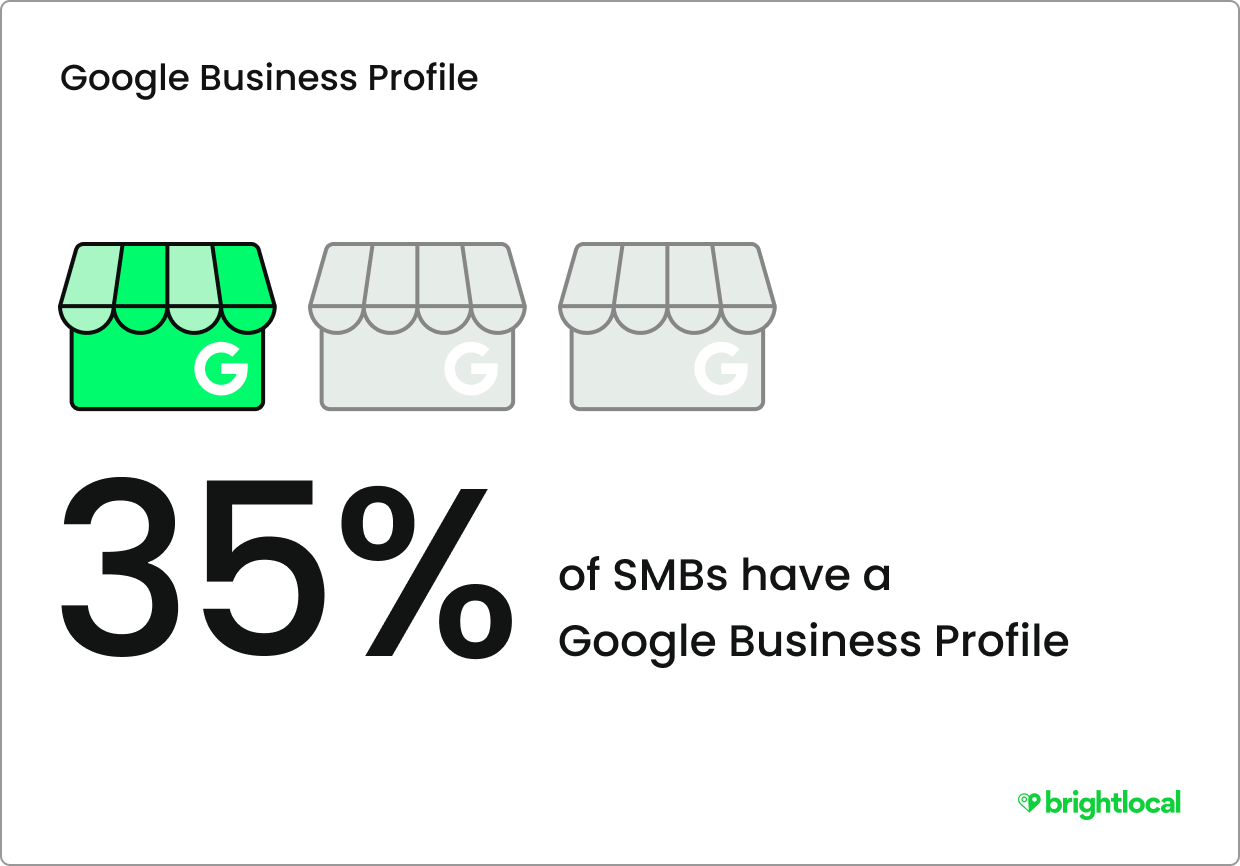
Next, just 35% of SMBs say they have a Google Business Profile
This was a surprising finding for us, as GBP is probably the area of local SEO that our teams are most often asked about. It’s a good reminder for us, as local marketers, and for consultants and agencies out there pitching to local businesses, that many SMBs simply do not know what they need for successful local marketing online.
This is reflected further with the findings that only 17% of SMBs say they are using business directories, and just 15% use review platforms. Of course, this could mean that small to medium businesses do have profiles on these platforms, but aren’t actively using them to market their businesses. But even if that is the case, it’s severely missing the opportunity to boost local visibility, increase customer engagement (and encourage advocacy), and build an overall strong brand perception.
3. Actionable marketing tactics for SMBs
We break down some of the local marketing tactics that SMBs can look to implement immediately, no matter their level of expertise, and some more strategic, long-term actions.
Traditional and local SEO as a long-term investment
It’s clear from the impact that SMBs believe SEO has on their business, compared to the platforms they’re actually using to market themselves, that the practice of SEO is not being implemented (and possibly understood) to its full potential. As we touched on earlier, our findings suggest that levels of awareness are high enough that business owners know they need to be doing it, but they view tasks as more of a checklist activity rather than as a strategy in its own right.
SEO and local SEO strategies are detailed plans that should feed into the overall marketing strategy. While it’s important to see an SEO strategy as a plan in its own right, feeding it into your marketing plan will help you understand how various tasks and tactics work together, and how you can align activities such as content, SEO, and social media to be more effective.
Considering ‘attracting new customers’ is the top marketing priority for SMBs, it makes perfect sense to invest in a strategy that is built around users that are actively searching for businesses, products, and services just like yours. And, while paid strategies will also support this goal, the benefits of attaining customers through organic means can be more cost-effective and yield consistent results over time. Maintaining organic and local visibility helps to strengthen your authority as a known and trusted business wherever your customers are searching—including search tools, social media, directories and even AI platforms.
Free Academy course: Create a Winning Local SEO Strategy for Any Business
Tactics to implement right away
Claim and optimize your GBP (and other business listings)
With at least six in ten consumers taking to Google Search or Google Maps as their first port of call for local business searches, not having a Google Business Profile will severely impact your visibility across these platforms. Anyone searching for a business like yours in Google’s search products will be served local results (via the local pack or map pack) where the businesses have a GBP.
While this isn’t the case for organic Google Search results, local pack results generally appear at the top of a local SERP and cater to users based on the proximity of their search. Simply, it isn’t enough to rely on your business appearing underneath the map pack in organic search results (which, realistically, you need a website to do!).
The process of setting up your GBP is very simple and, apart from waiting for your profile to be verified, it’s also quick to do. But don’t consider it a one and done task.
There are many different ways of optimizing your GBP so that it displays the most useful and relevant information to users, from selecting multiple business categories and adding products or services, to populating your profile with recent, high-quality images. All of this information is used by Google to surface the results it deems to be most relevant to a user’s search—even down to the details pictured in your images.
On the subject of claiming business profiles, another immediate action that you can take is claiming other prominent business directory listings. Next to Google, the top most authoritative listings are Facebook, Bing, Apple and Yelp, so you should aim to set these up at the absolute minimum.
One of the most misunderstood parts of listings management is down to so many people just viewing them as online address-book entries. Business directories can boost local visibility, as relevant and authoritative listing websites often appear in organic search results. Plus, they are vital for building trust with prospective customers, as they look to these types of websites for vital business information, such as addresses, opening hours and contact details.
Build a business website
This one isn’t exactly ‘quick’ but if you don’t have a business website set up, we recommend actioning this straight away.
A business website can feel like a costly investment for a small to medium sized business, but the long-term benefits far outweigh this. Your business website is essentially a digital ‘shop window’—it’s your opportunity to tell potential customers everything they need to know about your business, and therefore why it’s the best choice for them.
Yes, you may use a Facebook Page or similar to manage business updates in real-time, but you should think of your own website as the one place where you truly own and control all of the content that sits on it. Not to mention the opportunities for optimization that will help ensure your website appears in search engine results.
Whilst SEO is possible without a website of your own, you’re severely limiting the control you can have over your business information, online presence, and brand consistency.
View review management as a proactive tactic rather than reactive
Setting up a GBP will tick off one review platform, and fortunately it is the biggest review platform in the world, thanks to its integration in both Google Search and Google Maps.
However, it’s always a good idea to set up review profiles across multiple platforms and provide your customers with options to leave reviews on these. Ultimately, different consumers will have their preferences. For hospitality businesses, for example, some customers may prefer to leave reviews on websites like Tripadvisor or Yelp.
Next, try to avoid seeing business reviews as just something you monitor and engage with reactively. Making review management an active part of your local marketing strategy is beneficial for many reasons. Not only do a stream of regular business reviews provide prospective customers with a sense of who you are and what to expect, they are also a key ranking factor as far as Google is concerned. Plus, having a consistent reputation across different review platforms helps users doing their research to feel more comfortable in their choices.
Factor in requesting reviews from your customers as a regular part of your customer service. The way in which you do this may depend on your industry, but our consumer review research points to some effective methods and tips.
Strategic recommendations for SMBs
Leverage your presence on social media
Our findings show that a large portion of SMBs are more likely to use platforms like Facebook and Instagram than a dedicated website or GBP to market themselves online. So, if you feel that social media is something you ‘get,’ and enjoy using for your business—that’s great! But you can take this up a level and truly integrate your social activity with local marketing tactics and grow your online visibility.
Firstly, many social platforms have evolved to tools for local business discovery, enabling you to claim an official ‘business’ profile where you can display your business opening hours and other key information. Facebook, for example, is actually a key authority in the business listings world, so taking the time to fully optimize your business page is a win-win.
As well as core business information, use your social profiles to engage with your community and potential customers. Post actively to share updates on products and services, any promotions you might be running, and even to share the ‘human’ element of your business—behind the scenes content, or photos and videos involving your team are always good for engagement. Plus, you can use social media to direct people to your website, or to leave business reviews on other platforms.
“Once your social channels are set up, using them doesn’t have to take up a huge amount of time, resource, or investment.
In reality, people respond better to authentic social channels. You don’t need clever marketing campaigns, or professionally designed images. If you show the ‘behind-the-scenes’ of running your business, or serving your customers, people will respond well.
Additionally, using social media as a communications channel, where you can have an active presence and respond to customer questions in a timely way, is going to be beneficial.”
Recognize when you need help
As we found, many small to medium business owners are managing marketing entirely on their own. While the costs of hiring to invest in your marketing further can feel risky, there is also a chance that your own lack of time or marketing expertise is holding you back from achieving results. Treating local marketing as just something else on your list of things to manage isn’t looking at the big picture or the long-term.
You have several routes here. If delegation or hiring really is not an option for you right now, upskilling and education is a good place to start. BrightLocal Academy has a pathway of free local SEO courses, suitable for small business owners and local marketing beginners. We also host free, live webinars with actionable tips for key areas such as your Google Business Profile, with opportunities to ask experts questions live.
Don’t forget your local business and marketing communities. You can join online communities, such as our own Facebook group, The Local Pack, to ask other business owners and managers like you for advice, as well as long-time experts in local marketing. The Local Search Forum is another great community resource, where many experts share their helpful tips and experience.
You might also want to consider outsourcing local SEO to marketing experts. This can be a good option for smaller businesses who aren’t sure if they want to commit to the full-time hiring of a marketing employee or team.
Summary
It’s clear from these findings that, while the majority of small to medium businesses are feeling optimistic about the year ahead and believe in the impact of SEO, a critical gap exists between this perception and their actual digital presence.
We’ve learned that SMBs face real challenges around profitability and cash flow, making it difficult to forward-plan. With so many business owners taking on marketing entirely by themselves, marketing strategy appears to fall to the wayside as owners focus on ‘getting things done.’
The good news is that there are plenty of opportunities SMBs can act on right away to strengthen their online visibility, without necessarily eating into budgets. SMB owners are resilient and remain optimistic, and generally believe in the impact of organic channels like SEO and social media.
If you have any questions about this research, you can email the research team, post in The Local Pack, or reach us on our socials via LinkedIn, Bluesky, and X.


